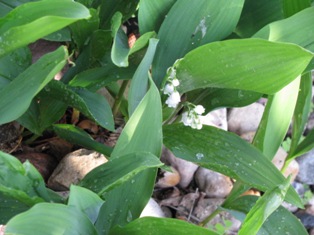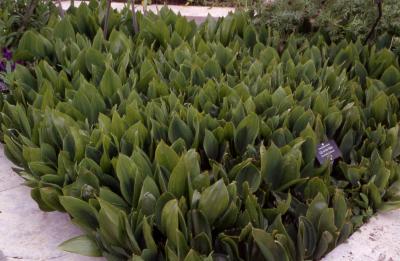The weather is starting to act more and more like spring these days. We have fewer cold days and more warm temperatures. Now is the time of the year when we really start to plan our landscapes, including changes and additions to our lawns and gardens. One great plant to incorporate into a shady area of your landscape is Lily-of-the-Valley. Photo below by Sharon Skipton, UNL Extension.
Lily of the Valley by Sharon Skipton, UNL ExtensionLily-of-the-Valley (Convallaria majalis) is a groundcover that can rapidly spread in an area of your garden or acreage. It has deep green leaves that appear from a tightly rolled cylinder, usually 2-3 base leaves in the plant that poke up through mulch. As the leaves grow, they unroll. The small white bell-shaped flowers appear in April and May. The fragrant flowers are on nodding stalks. Although rarely present, fruits are small reddish-orange berries.
Lily-of-the-Valley can be found in a pink flowering variety, 'Dora' or 'Rosea'. There is also a variety that was selected for larger flowers and stronger stalks, 'Bordeaux'. Otherwise, the straight species is a very beautiful ground cover for use on your acreage or any landscape.
Lily-of- the-Valley will spread quickly. Photo of groundcover is from Illinois Extension. Make sure that you plant it in an area where it can spread, and put a barrier between where you are growing Lily-of-the-Valley and where any lawn or other garden begins. It prefers to grow in part to full shade and can tolerate average to moist areas. If you are concerned with the rapid spreading, you can plant it in the root zone of trees or shrubs or withhold water from the plants, according to Kim Todd, UNL Professor.
This plant is easy to grow and would be a good choice for the low-maintenance areas of your acreage. If you want to plant some, ask around, as maybe one of your friends has a plant to share with you. It is easily propagated via division. This way you could both enjoy the plant at minimal cost. Lily-of-the-Valley also is sold in garden centers and in seed catalogs.
All parts of the plant are poisonous so avoid accidental ingestion by pets and children. The flowers make good cut flowers, as they will survive for 3-6 days in a floral arrangement. The leaves can be used to make a green dye, according to John Linnaeus.
Lily-of-the-Valley is a great plant choice for areas around trees, in shade, or other areas that need a groundcover. It takes very little maintenance once established, so it is a great choice for many acreage locations.


